The point geom is used to create scatterplots.
Usage
geom_point(
mapping = NULL,
data = NULL,
stat = "identity",
position = "identity",
...,
na.rm = FALSE,
show.legend = NA,
inherit.aes = TRUE
)Arguments
- mapping
Set of aesthetic mappings created by
aesoraes_. If specified andinherit.aes = TRUE(the default), it is combined with the default mapping at the top level of the plot. You must supplymappingif there is no plot mapping.- data
The data to be displayed in this layer. There are three options:
If
NULL, the default, the data is inherited from the plot data as specified in the call toggplot.A
data.frame, or other object, will override the plot data. All objects will be fortified to produce a data frame. Seefortifyfor which variables will be created.A
functionwill be called with a single argument, the plot data. The return value must be adata.frame., and will be used as the layer data.- stat
The statistical transformation to use on the data for this layer, as a string.
- position
Position adjustment, either as a string, or the result of a call to a position adjustment function.
- ...
other arguments passed on to
layer. These are often aesthetics, used to set an aesthetic to a fixed value, likecolor = "red"orsize = 3. They may also be parameters to the paired geom/stat.- na.rm
If
FALSE(the default), removes missing values with a warning. IfTRUEsilently removes missing values.- show.legend
logical. Should this layer be included in the legends?
NA, the default, includes if any aesthetics are mapped.FALSEnever includes, andTRUEalways includes.- inherit.aes
If
FALSE, overrides the default aesthetics, rather than combining with them. This is most useful for helper functions that define both data and aesthetics and shouldn't inherit behaviour from the default plot specification, e.g.borders.
Details
The scatterplot is useful for displaying the relationship between two
continuous variables, although it can also be used with one continuous
and one categorical variable, or two categorical variables. See
geom_jitter for possibilities.
The bubblechart is a scatterplot with a third variable mapped to the size of points. There are no special names for scatterplots where another variable is mapped to point shape or colour, however.
The biggest potential problem with a scatterplot is overplotting: whenever
you have more than a few points, points may be plotted on top of one
another. This can severely distort the visual appearance of the plot.
There is no one solution to this problem, but there are some techniques
that can help. You can add additional information with
geom_smooth or
geom_density_2d. Alternatively, you can
summarise the number of points at each location and display that in some
way, using stat_sum. Another technique is to use transparent
points, e.g. geom_point(alpha = 0.05).
Aesthetics
geom_point understands the following aesthetics (required aesthetics are in bold):
x
y
alpha
colour
fill
shape
size
stroke
See also
scale_size to see scale area of points, instead of
radius, geom_jitter to jitter points to reduce (mild)
overplotting
Examples
p <- ggplot(mtcars, aes(wt, mpg))
p + geom_point()
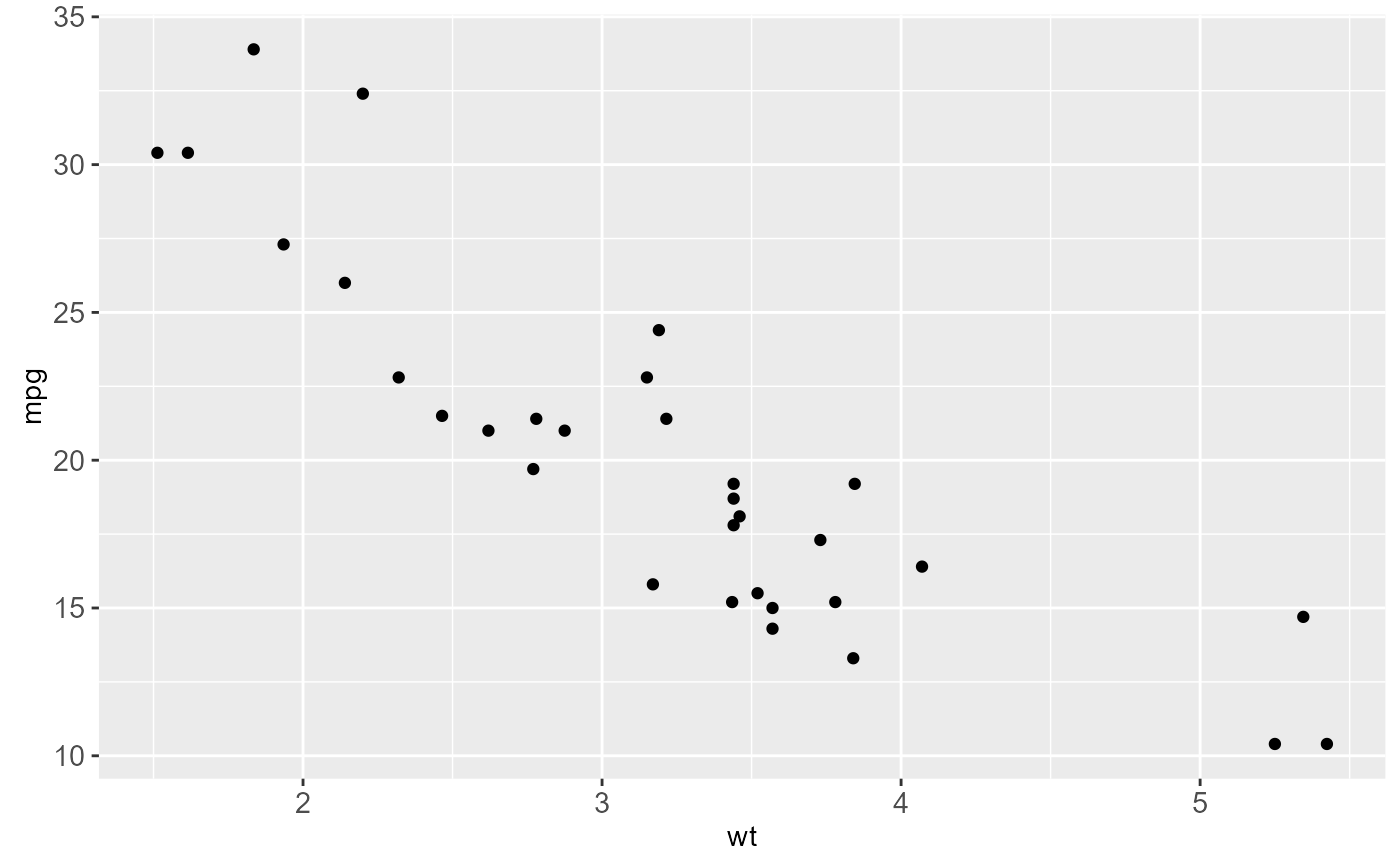 # Add aesthetic mappings
p + geom_point(aes(colour = factor(cyl)))
# Add aesthetic mappings
p + geom_point(aes(colour = factor(cyl)))
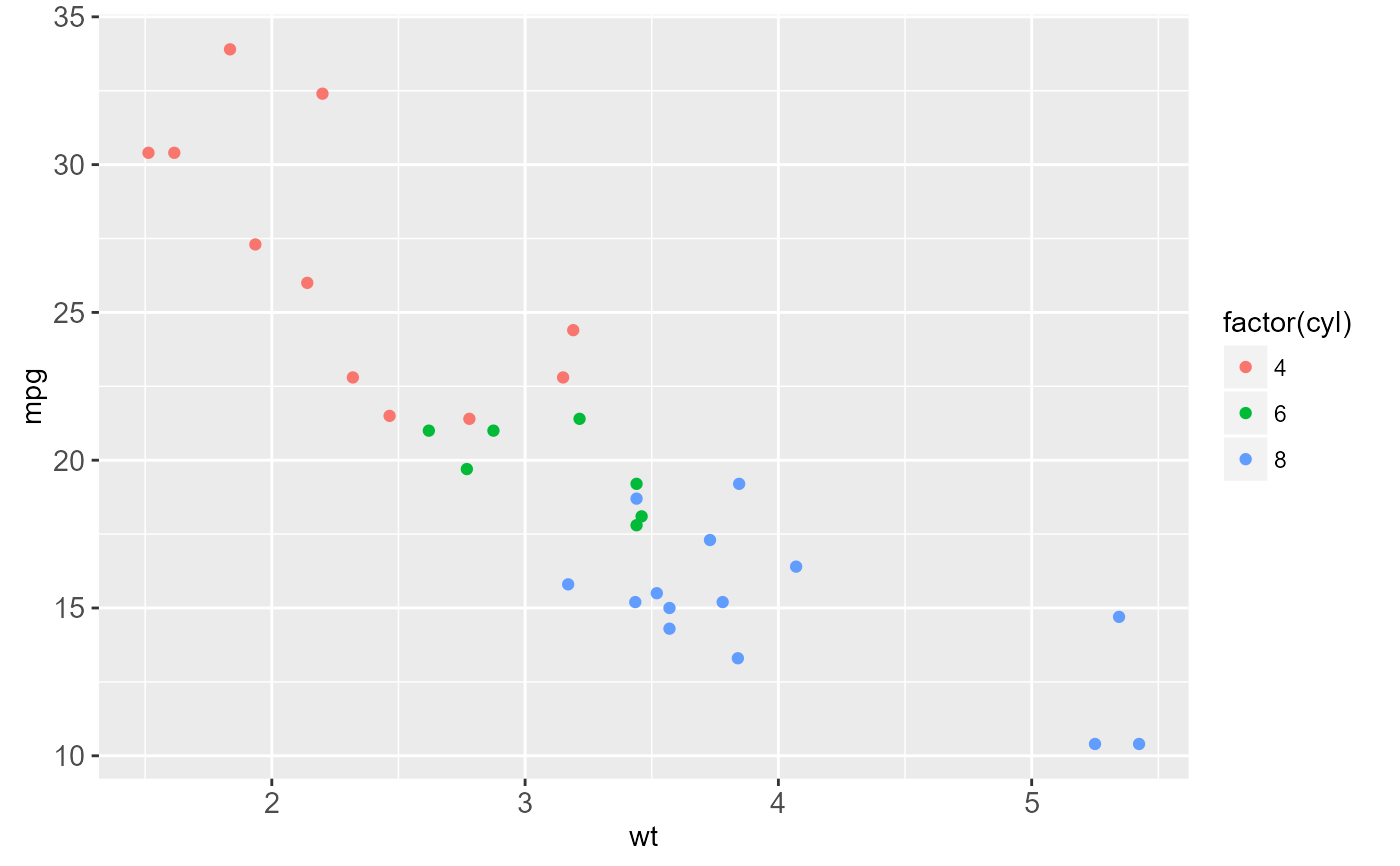 p + geom_point(aes(shape = factor(cyl)))
p + geom_point(aes(shape = factor(cyl)))
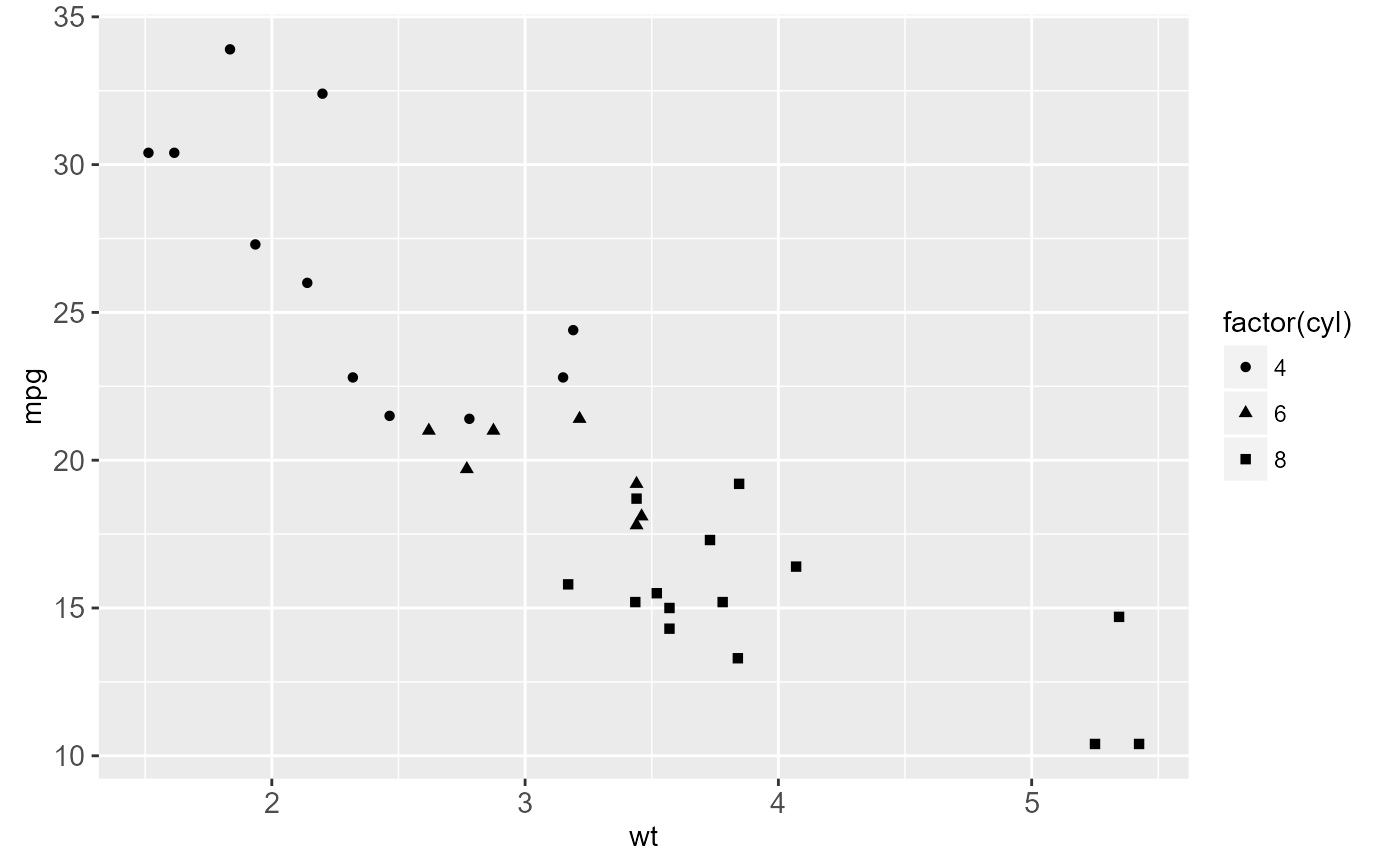 p + geom_point(aes(size = qsec))
p + geom_point(aes(size = qsec))
 # Change scales
p + geom_point(aes(colour = cyl)) + scale_colour_gradient(low = "blue")
# Change scales
p + geom_point(aes(colour = cyl)) + scale_colour_gradient(low = "blue")
 p + geom_point(aes(shape = factor(cyl))) + scale_shape(solid = FALSE)
p + geom_point(aes(shape = factor(cyl))) + scale_shape(solid = FALSE)
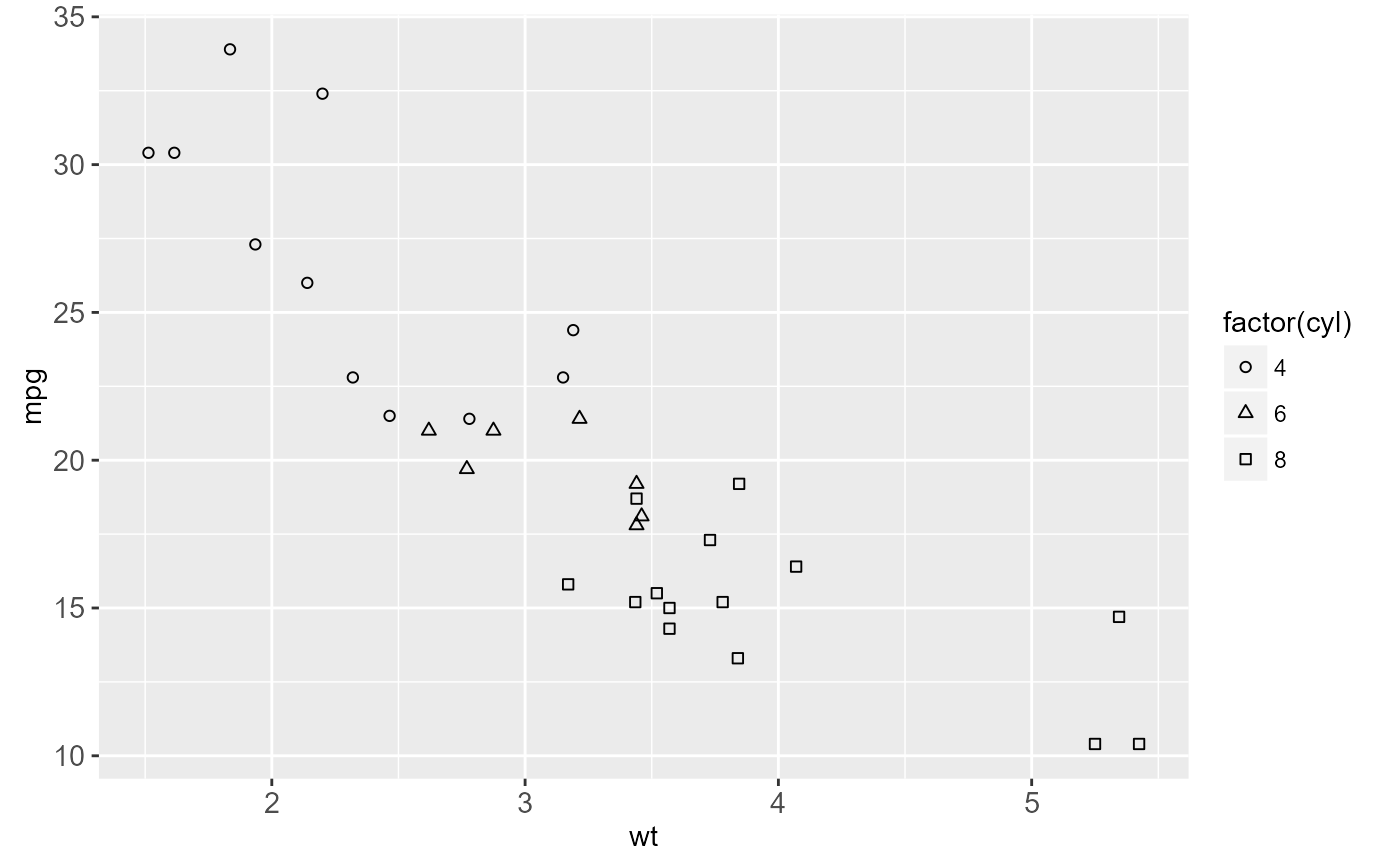 # Set aesthetics to fixed value
ggplot(mtcars, aes(wt, mpg)) + geom_point(colour = "red", size = 3)
# Set aesthetics to fixed value
ggplot(mtcars, aes(wt, mpg)) + geom_point(colour = "red", size = 3)
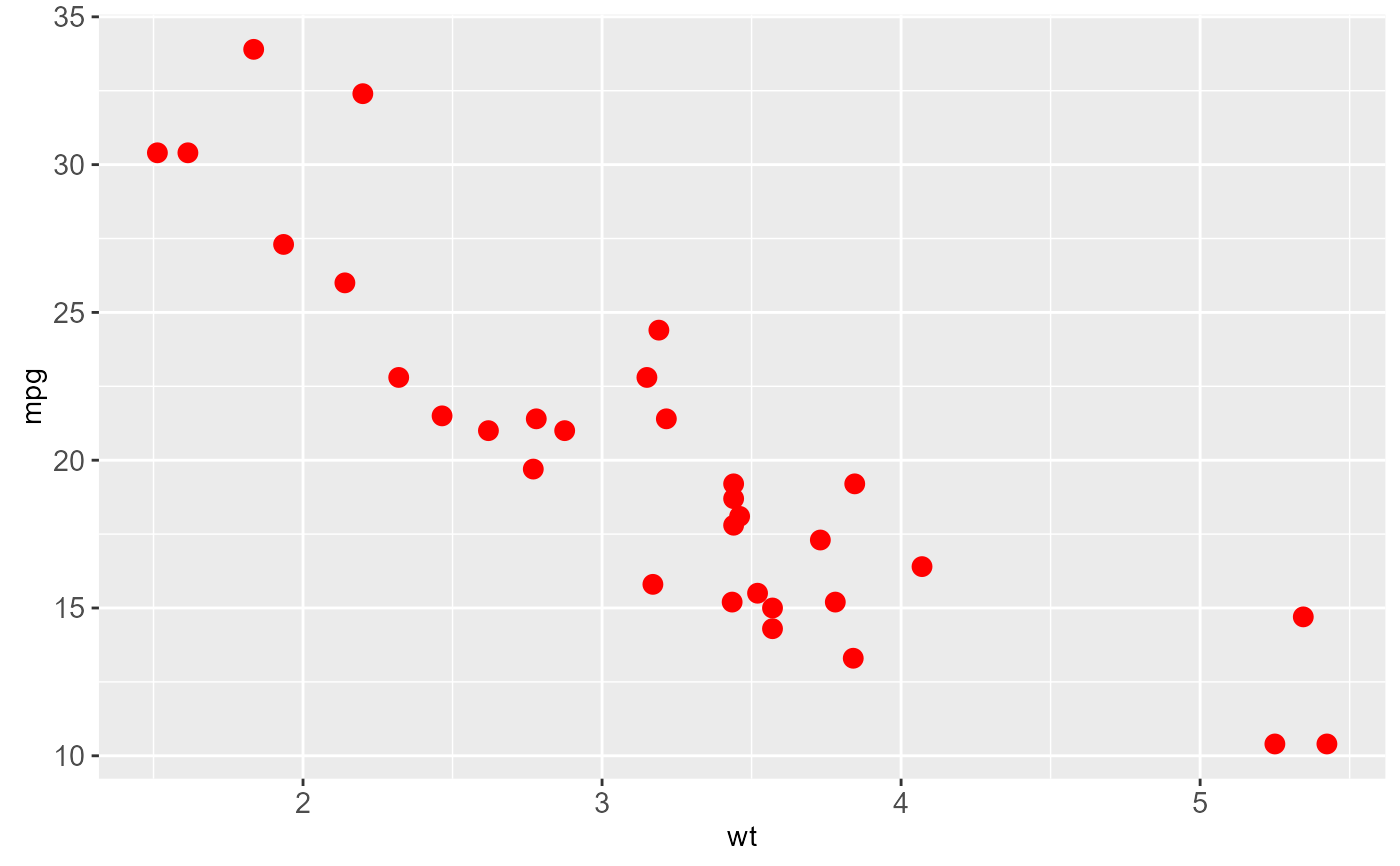 # \donttest{
# Varying alpha is useful for large datasets
d <- ggplot(diamonds, aes(carat, price))
d + geom_point(alpha = 1/10)
# \donttest{
# Varying alpha is useful for large datasets
d <- ggplot(diamonds, aes(carat, price))
d + geom_point(alpha = 1/10)
 d + geom_point(alpha = 1/20)
d + geom_point(alpha = 1/20)
 d + geom_point(alpha = 1/100)
d + geom_point(alpha = 1/100)
 # }
# For shapes that have a border (like 21), you can colour the inside and
# outside separately. Use the stroke aesthetic to modify the width of the
# border
ggplot(mtcars, aes(wt, mpg)) +
geom_point(shape = 21, colour = "black", fill = "white", size = 5, stroke = 5)
# }
# For shapes that have a border (like 21), you can colour the inside and
# outside separately. Use the stroke aesthetic to modify the width of the
# border
ggplot(mtcars, aes(wt, mpg)) +
geom_point(shape = 21, colour = "black", fill = "white", size = 5, stroke = 5)
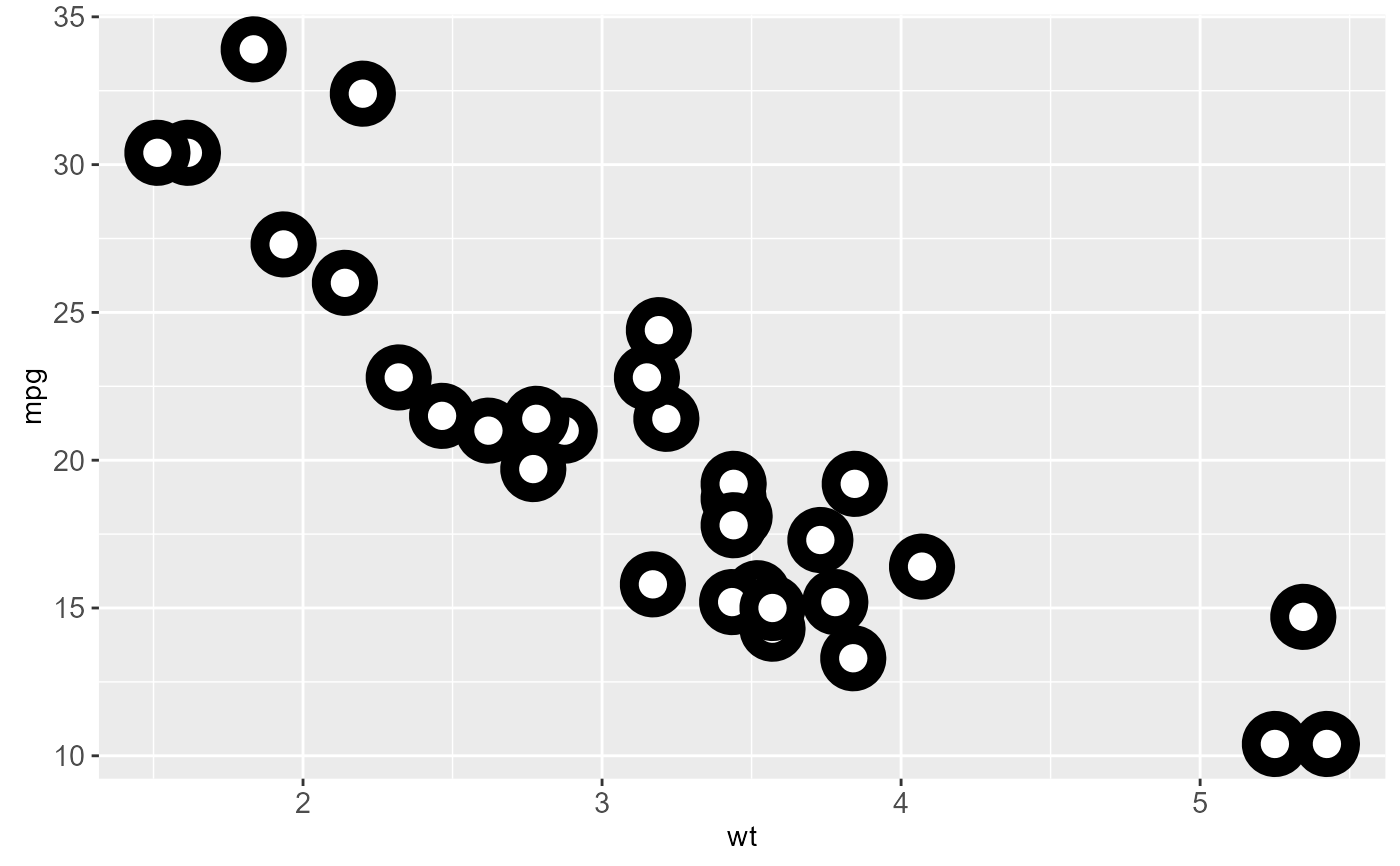 # \donttest{
# You can create interesting shapes by layering multiple points of
# different sizes
p <- ggplot(mtcars, aes(mpg, wt, shape = factor(cyl)))
p + geom_point(aes(colour = factor(cyl)), size = 4) +
geom_point(colour = "grey90", size = 1.5)
# \donttest{
# You can create interesting shapes by layering multiple points of
# different sizes
p <- ggplot(mtcars, aes(mpg, wt, shape = factor(cyl)))
p + geom_point(aes(colour = factor(cyl)), size = 4) +
geom_point(colour = "grey90", size = 1.5)
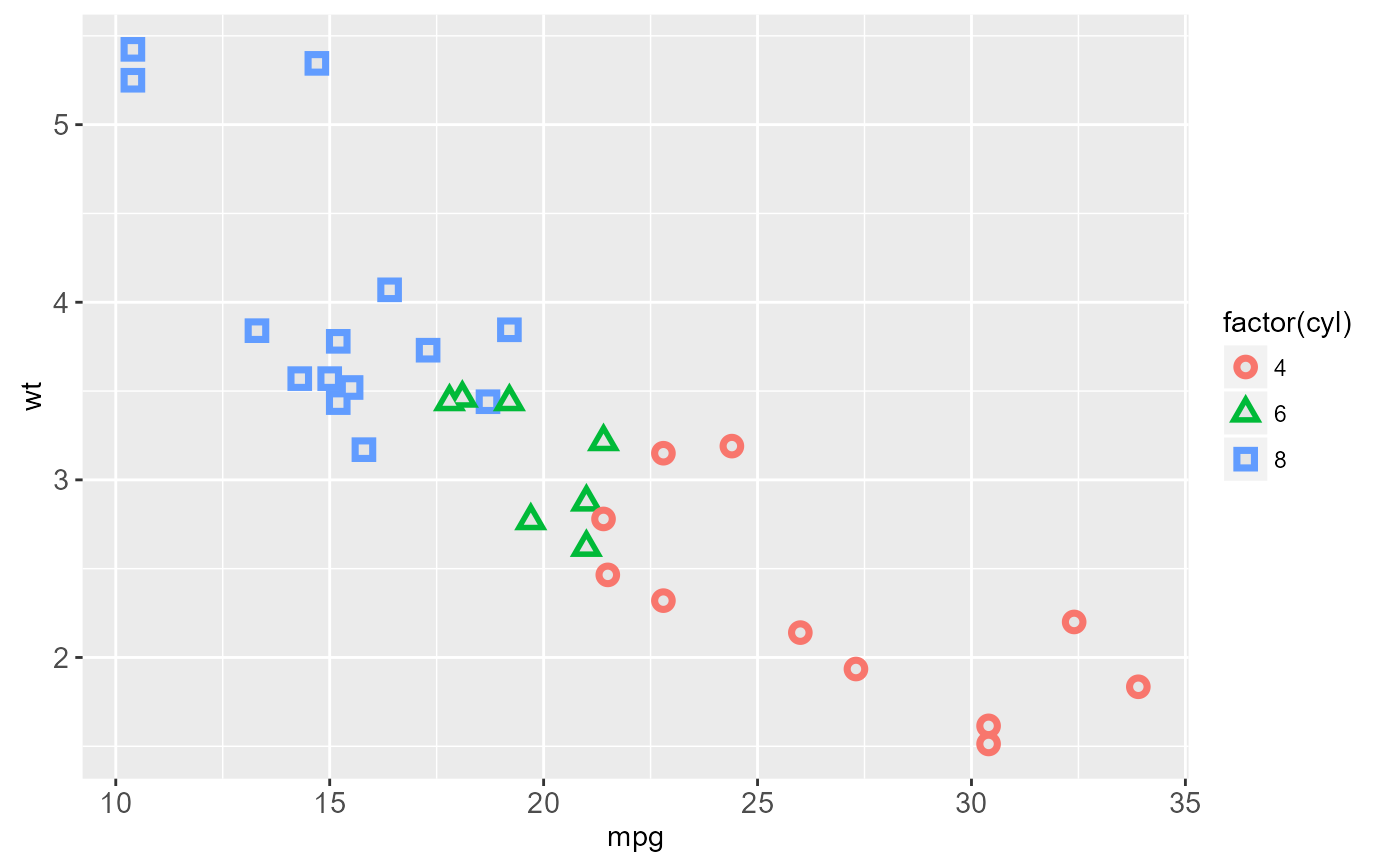 p + geom_point(colour = "black", size = 4.5) +
geom_point(colour = "pink", size = 4) +
geom_point(aes(shape = factor(cyl)))
p + geom_point(colour = "black", size = 4.5) +
geom_point(colour = "pink", size = 4) +
geom_point(aes(shape = factor(cyl)))
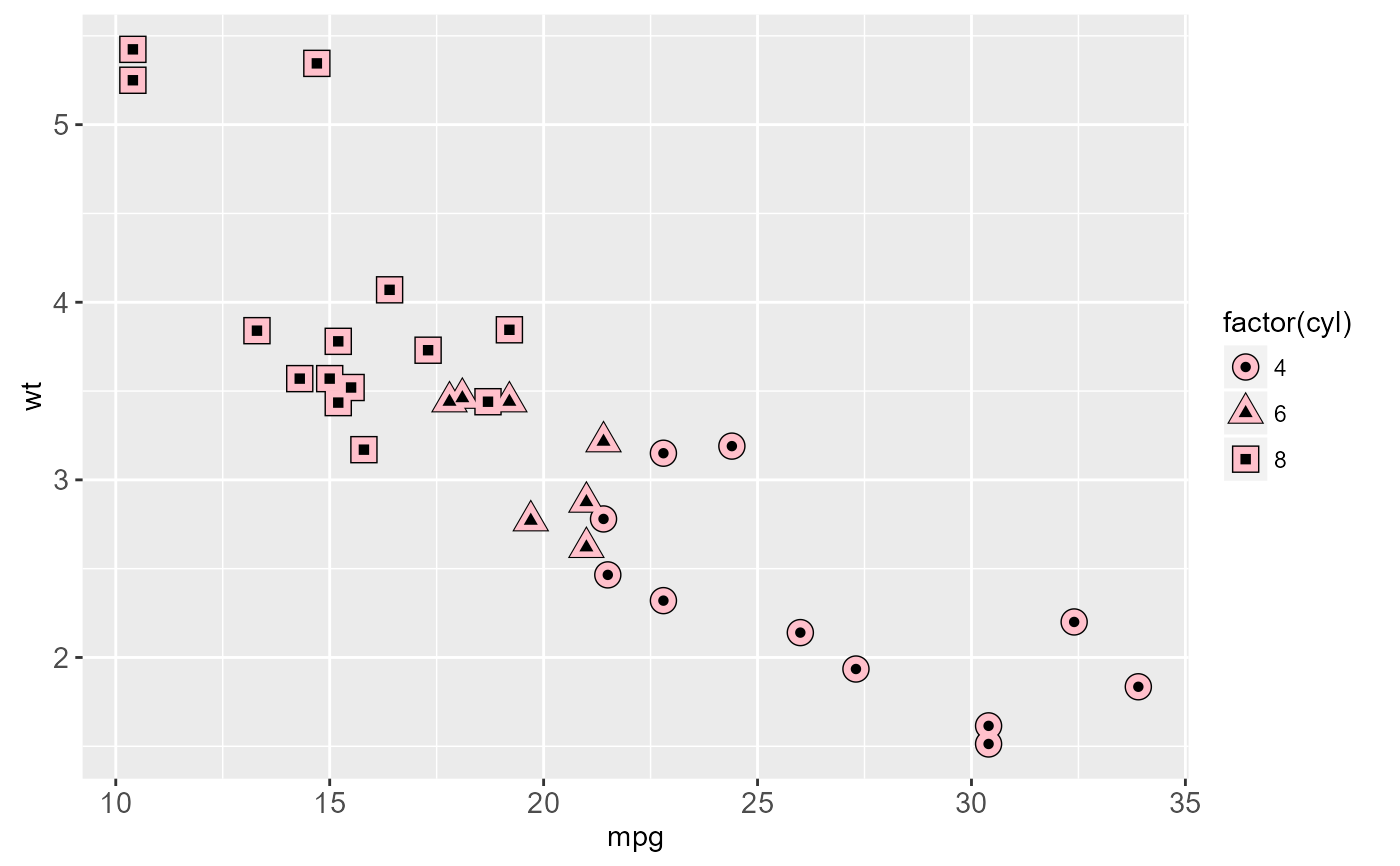 # These extra layers don't usually appear in the legend, but we can
# force their inclusion
p + geom_point(colour = "black", size = 4.5, show.legend = TRUE) +
geom_point(colour = "pink", size = 4, show.legend = TRUE) +
geom_point(aes(shape = factor(cyl)))
# These extra layers don't usually appear in the legend, but we can
# force their inclusion
p + geom_point(colour = "black", size = 4.5, show.legend = TRUE) +
geom_point(colour = "pink", size = 4, show.legend = TRUE) +
geom_point(aes(shape = factor(cyl)))
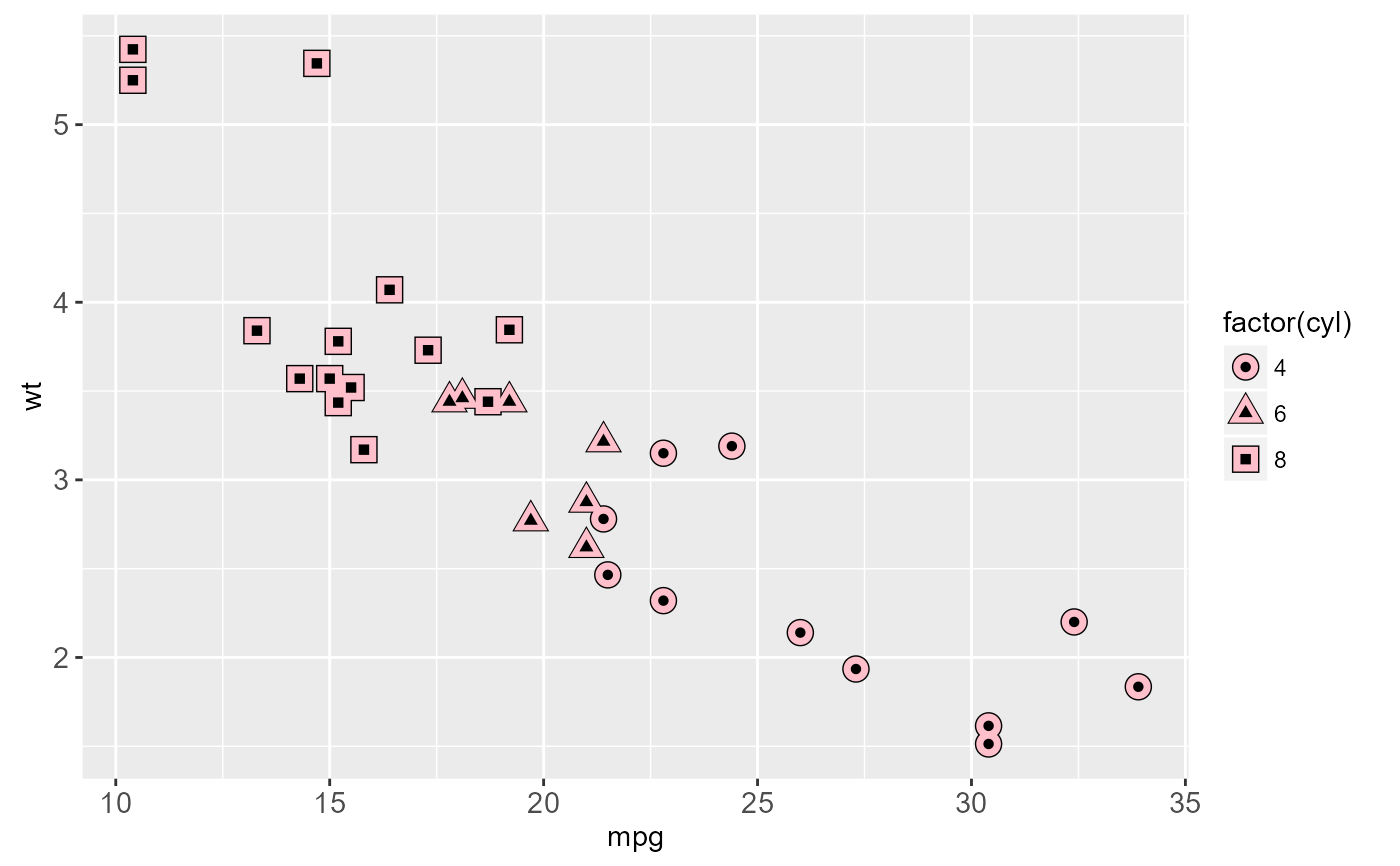 # geom_point warns when missing values have been dropped from the data set
# and not plotted, you can turn this off by setting na.rm = TRUE
mtcars2 <- transform(mtcars, mpg = ifelse(runif(32) < 0.2, NA, mpg))
ggplot(mtcars2, aes(wt, mpg)) + geom_point()
#> Warning: Removed 2 rows containing missing values (geom_point).
# geom_point warns when missing values have been dropped from the data set
# and not plotted, you can turn this off by setting na.rm = TRUE
mtcars2 <- transform(mtcars, mpg = ifelse(runif(32) < 0.2, NA, mpg))
ggplot(mtcars2, aes(wt, mpg)) + geom_point()
#> Warning: Removed 2 rows containing missing values (geom_point).
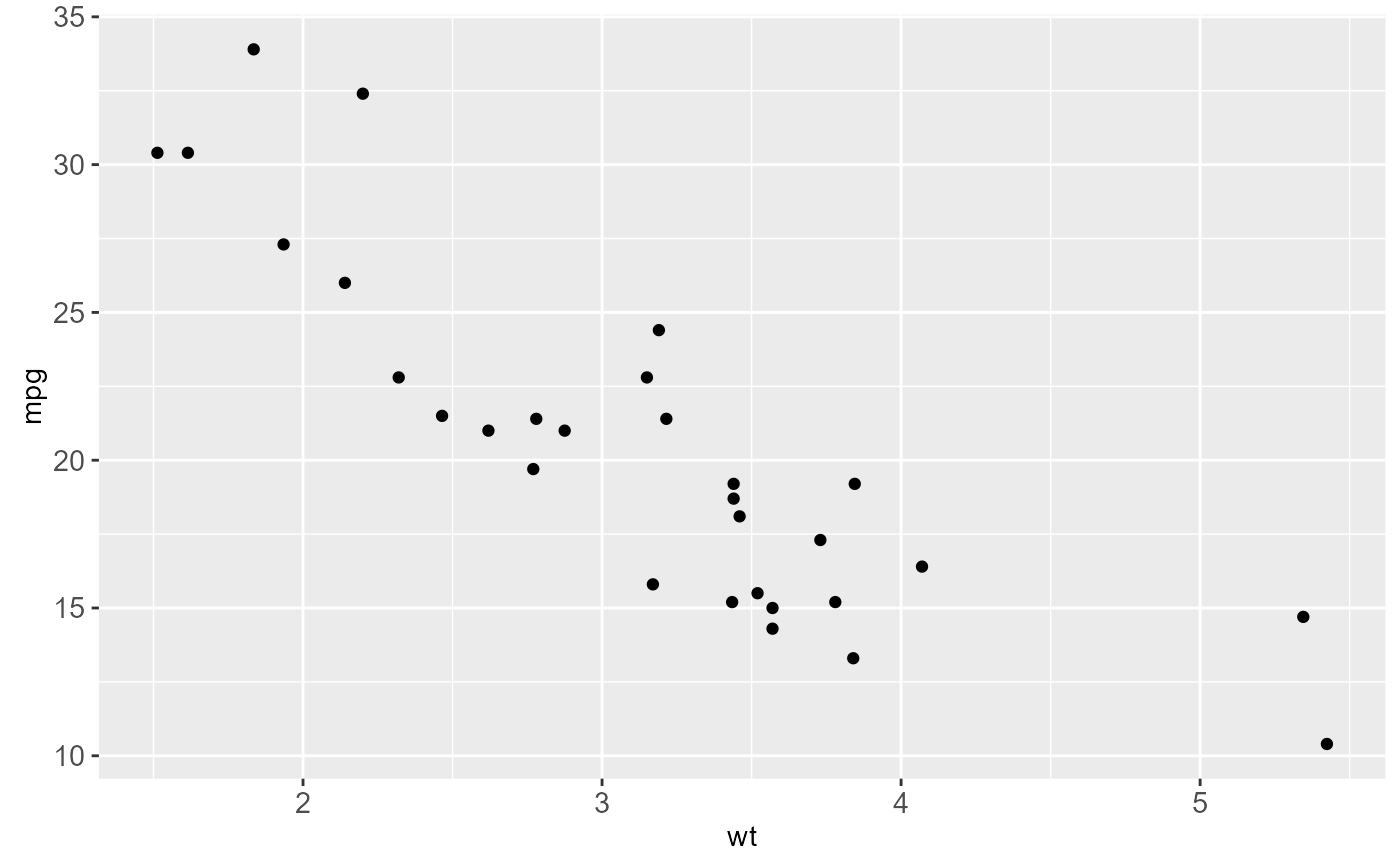 ggplot(mtcars2, aes(wt, mpg)) + geom_point(na.rm = TRUE)
ggplot(mtcars2, aes(wt, mpg)) + geom_point(na.rm = TRUE)
 # }
# }